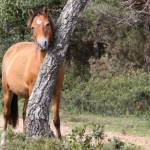Trees Identified as Cause of Atypical Myopathy

Atypical myopathy, a muscle disease that can be fatal to European horses, has been linked to ingestion of toxins in the seeds of the sycamore maple, also known in the United Kingdom as the sycamore. This tree, Acer pseudoplatanu, is in the maple genus and is not the same tree as the American sycamore (Platanus occidentalis).
Atypical myopathy has been reported in about 20 European countries. Most cases occur in the fall and sometimes in the spring after a large fall outbreak has occurred. Affected horses typically have been turned out in pastures with sparse forage and have often not been given supplemental hay or feed. In a study on atypical myopathy that involved affected horses living in three European countries, the sycamore maple was found to be the only tree common to all the horses’ pastures. Horses in the study all had high serum concentrations of a toxic metabolite of hypoglycin A, a substance found in the seeds of sycamore maples.
Recent research in the United States has shown that seeds of box elder (Acer negundo), another species of maple, contain the same toxic substance. Horses ingesting these seeds can be affected with seasonal pasture myopathy, a disease similar to atypical myopathy. This malady is seen in the midwestern US states and eastern Canada.
The seasonal aspect of both diseases may be due to several factors. During times of low rainfall when pasture forage becomes scarce, trees under drought stress may increase the concentration of hypoglycin A in their seeds. With less forage available, horses may bite off foliage closer to the ground, inadvertently picking up the seeds. Very hungry horses may eat the seeds by choice if there is little else to ingest. Autumn storms and winds may play a role by driving seeds into the pastures during this season.
If horses must be turned out on sparse pasture in the vicinity of sycamore maple and box elder tree, owners can minimize exposure to the seeds by offering hay and supplemental feed. The hay should be placed in areas that are free of seeds.








